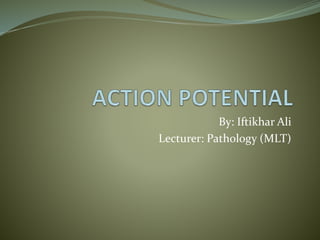
Action potential
- 1. By: Iftikhar Ali Lecturer: Pathology (MLT)
- 2. EXCITABILITY Excitability is defined as the physiochemical change that occurs in a tissue when stimulus is applied. STIMULUS is defined as an external agent, which produces excitability in the tissues. TYPES OF STIMULUS Stimuli, which can excite the tissue are of four types : 1. Mechanical stimulus (pinching) 2. Electrical stimulus (electric shock)
- 3. 3. Thermal stimulus (applying heated glass rod or ice piece) 4. Chemical stimulus (applying chemical substances like acids). QUALITIES OF STIMULUS To excite a tissue, the stimulus must possess two characters: 1. Intensity or strength 2. Duration.
- 4. Intensity Intensity or strength of a stimulus is of five types: i. Subminimal stimulus ii. Minimal stimulus iii. Submaximal stimulus iv. Maximal stimulus v. Supramaximal stimulus. Stimulus whose strength (or voltage) is sufficient to excite the tissue is called threshold or liminal or minimal stimulus. Nerve fibers have a low threshold for excitation than the other cells.
- 5. Duration Whatever may be the strength of the stimulus, it must be applied for a minimum duration to excite the tissue. However, the duration of a stimulus depends upon the strength of the stimulus. For a weak stimulus the duration is longer and for a stronger stimulus, the duration is shorter.
- 6. RESTING MEMBRANE POTENTIAL Resting membrane potential is defined as the electrical potential difference (voltage) across the cell membrane (between inside and outside of the cell) under resting condition. It is also called membrane potential, transmembrane potential, transmembrane potential difference or transmembrane potential gradient. POTENTIAL The difference in electrical charge between two points
- 8. Response Due to Stimulation of Nerve Fiber When a nerve fiber is stimulated, based on the strength of stimulus, two types of response develop: 1. Action potential or nerve impulse Action potential develops in a nerve fiber when it is stimulated by a stimulus with adequate strength. Adequate strength of stimulus, necessary for producing the action potential in a nerve fiber is known as threshold or minimal stimulus. Action potential is propagated.
- 9. Electrotonic potential or local potential When the stimulus with subliminal strength is applied, only electrotonic potential develops and the action potential does not develop. Electrotonic potential is nonpropagated.
- 10. ACTION POTENTIAL Action potential is defined as a series of electrical changes that occur in the membrane potential when the muscle or nerve is stimulated. Action potential occurs in two phases: 1. Depolarization 2. Repolarization.
- 11. Depolarization Depolarization is the initial phase of action potential in which inside of the neuron becomes positive and outside becomes negative. That is, the polarized state (resting membrane potential) is abolished resulting in depolarization.
- 12. Repolarization Repolarization is the phase of action potential in which the muscle reverses back to the resting membrane potential. That is, within a short time after depolarization the inside of nerve becomes negative and outside becomes positive. So, the polarized state of the muscle is reestablished.
- 13. ACTION POTENTIAL CURVE Action potential curve is the graphical registration of electrical activity that occurs in an excitable tissue such as muscle and nerve after stimulation. It shows three major parts: 1. Latent period 2. Depolarization 3. Repolarization.
- 14. Latent Period Latent period is the period when no change occurs in the electrical potential immediately after applying the stimulus. It is a very short period with duration of 0.5 to 1 millisecond. Stimulus artifact When a stimulus is applied, there is a slight irregular deflection of baseline for a very short period. This is called stimulus artifact.
- 15. Resting membrane potential in the nerve fiber is –70 mV. The firing level is at –55 mV. Depolarization ends at +35 mV. Usually, the action potential starts in the initial segment of nerve fiber.
- 16. A = Opening of few Na+ channels B = Opening of many Na+ channels C = Closure of Na+ channels and opening of K+ channels D = Closure of K+ channels
- 17. Depolarization Depolarization starts after the latent period. Initially, it is very slow and the Nerve is depolarized for about 15 mV. Firing level. After the initial slow depolarization for 15 mV (up to –75 mV), the rate of depolarization increases suddenly. The point at which, the depolarization increases suddenly is called firing level. Overshoot From firing level, the curve reaches isoelectric potential (zero potential) rapidly and then shoots up (overshoots) beyond the zero potential (isoelectric base) up to +35 mV. It is called overshoot.
- 18. Repolarization When depolarization is completed (+35 mV), the repolarization starts. Initially, the repolarization occurs rapidly and then it becomes slow. Spike potential Rapid rise in depolarization and the rapid fall in repolarization are together called spike potential. It lasts for 0.4 millisecond.
- 19. After depolarization or negative after potential Rapid fall in repolarization is followed by a slow repolarization. It is called after depolarization or negative after potential. Its duration is 2 to 4 milliseconds. After hyperpolarization or positive after potential After reaching the resting level (–90 mV), it becomes more negative beyond resting level. This is called after hyperpolarization or positive after potential. This lasts for more than 50 milliseconds. After this, the normal resting membrane potential is restored slowly.
- 20. CONDUCTIVITY Conductivity is the ability of nerve fibers to transmit the impulse from the area of stimulation to the other areas. Action potential is transmitted through the nerve fiber as nerve impulse.
- 21. MECHANISM OF CONDUCTION OF ACTION POTENTIAL Depolarization occurs first at the site of stimulation in the nerve fiber. It causes depolarization of the neighboring areas. Like this, depolarization travels throughout the nerve fiber. Depolarization is followed by repolarization.
- 22. Mode of conduction through nerve fibers A. Non-myelinated nerve fiber: continuous conduction. B. Myelinated nerve fiber: saltatory conduction (impulse jumps from node to node). AP = Action potential.